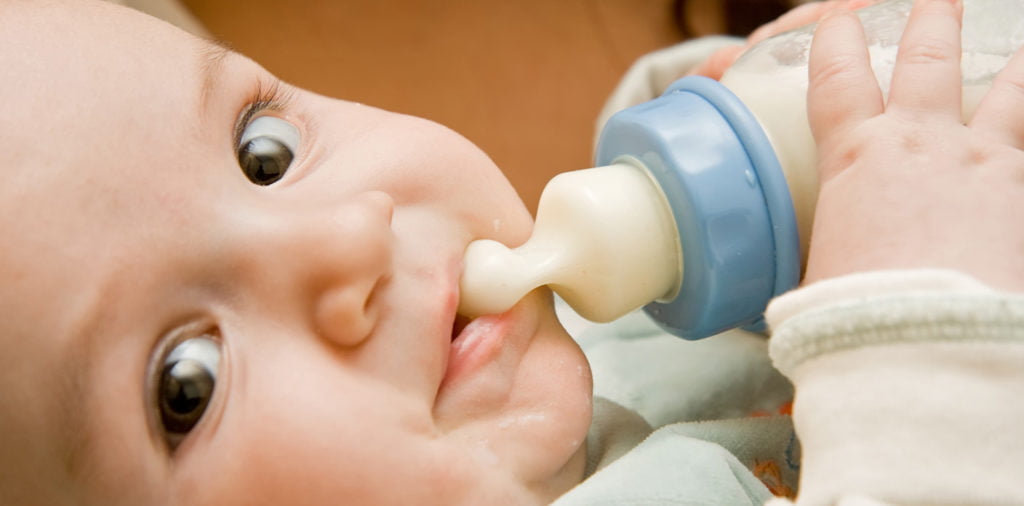Yes, bottle warmers are safe for breast milk. Bottle warmers can be an excellent tool for busy moms who want to quickly heat up their frozen or refrigerated breast milk.
They save time and make feeding easier. However, some moms worry that the heat from bottle warmers might destroy the vital nutrients in breast milk.
After a thorough study, it is now clear that bottle warmers are not harmful to breast milk but they are safe and provide a convenient way to warm up bottles without losing any of the nutrients in breast milk.
In this article, we will discuss how bottle warmers work, how to use them safely, and the benefits they provide to busy moms.


Credit: babybrezza.com
How Do Bottle Warmers Work?
Explanation Of What A Bottle Warmer Is
A bottle warmer is an appliance that helps in warming up milk bottles, and it can also be used to warm up food in other containers like jars and pouches.
Bottle warmers are designed to heat up bottles evenly, avoiding hot spots that can scald or overheat the milk. The warmers operate using steam, water, or air, depending on the type of device.
Different Types Of Bottle Warmers Available In The Market
There are different types of bottle warmers available in the market, and they vary on how they heat up milk bottles.
- Electric bottle warmers: these warmers are fast and efficient and use electricity to heat up the bottles. They usually come with an auto shut-off feature once the milk reaches the desired temperature.
- Water bath bottle warmers: these warmers use warm water to heat up bottles. They are effective and gentle on breast milk compared to other warmers.
- Portable bottle warmers: portable bottle warmers are ideal for traveling parents and those on-the-go. They use batteries or a power outlet and work quickly to heat up bottles.
Benefits Of Using Bottle Warmers To Warm Milk
Here are some of the benefits of using a bottle warmer to warm milk:
- Bottle warmers save time: they are designed to heat up the milk in a short time, and you do not have to sit around waiting for the milk to warm up.
- They preserve the nutrients in breast milk: using a bottle warmer to heat up milk causes less damage to the nutrients in breast milk compared to a microwave.
- Bottle warmers are safe: they are designed to heat up milk evenly, and you do not have to worry about hot spots forming in the milk, which can be dangerous to your baby.
- Consistency: bottle warmers heat up milk to a consistent temperature, ensuring your baby gets the best milk experience each time.
Using a bottle warmer is an effective and safe way to warm up breast milk for your little one. There are different types of bottle warmers available in the market, and each has its advantages and disadvantages.
Choose a bottle warmer that suits your needs and budget, and always follow the manufacturer’s instructions for optimal use and safety.
Can Bottle Warmers Be Used For Breast Milk?
Are bottle warmers safe for breast milk? This is a question that many new mothers often have when it comes to warming breast milk.
Bottle warmers are generally safe to use for breast milk; however, there are certain guidelines that must be followed to ensure the safety of the milk.
In this article, we will explore how breast milk differs from formula, how to store breast milk prior to warming it, and the do’s and don’ts of using bottle warmers for breast milk.
Explanation Of How Breast Milk Is Different From Formula
Breast milk is vastly different from formula in terms of its composition. Unlike formula, breast milk is rich in antibodies and other immune-boosting substances, making it an ideal source of nutrition for infants.
Formula, on the other hand, is made from a combination of chemicals and synthetic ingredients that attempt to mimic the nutrients found in breast milk.
Additionally, breast milk changes in composition as the baby grows, ensuring that they receive exactly what they need at each developmental stage.
How Breast Milk Should Be Stored Prior To Warming It
Proper storage of breast milk is crucial to maintain its safety and nutritional value.
- Store breast milk in clean, sterile containers with tight-fitting lids.
- Label breast milk containers with the date and time of expression.
- Store breast milk in the refrigerator or freezer immediately after expressing it.
- Breast milk can be stored in the refrigerator for up to four days and in the freezer for up to six months.
- To thaw frozen breast milk, place it in the refrigerator overnight or hold it under warm running water.
Do’S And Don’Ts Of Using Bottle Warmers For Breast Milk
Using bottle warmers for breast milk is generally safe as long as the proper guidelines are followed.
Do:
- Follow the manufacturer’s instructions for your bottle warmer.
- Test the temperature of the milk before giving it to your baby.
- Only warm breast milk that has been stored properly.
- Use a thermometer to ensure that the milk is at a safe temperature (around body temperature, or 98. 6°f).
Don’t:
- Warm breast milk in the microwave, which can cause hot spots and destroy the milk’s beneficial properties.
- Let the milk sit in the warmer for too long (more than 10 minutes), which can cause bacterial growth.
- Reheat breast milk that has already been warmed or partially consumed by your baby.
Following these guidelines will ensure that your breast milk is safely and appropriately warmed for your little one.
Safety Concerns With Using Bottle Warmers For Breast Milk
Are Bottle Warmers Safe For Breast Milk
Breast milk is a valuable source of nutrients for infants, and using a bottle warmer makes it more convenient for moms who want to store breast milk for later use.
However, safety concerns arise when heating breast milk with a bottle warmer. In this blog post, we will go over the safety concerns that come with using bottle warmers for breast milk.
Overheating Breast Milk: Risks Of Overheating And How To Avoid Them
Breast milk is a delicate substance, and if it’s overheated, it can lose its valuable nutrients.
- High temperatures can destroy some of the vitamins and minerals in breast milk.
- If it’s too warm, your baby might get burned.
- Overheating can create hot spots that can burn your baby’s mouth.
Here’s how to avoid overheating breast milk using a bottle warmer:
- Always follow the instructions on the bottle warmer.
- Test the temperature of the milk before feeding your baby.
- Do not heat the milk for too long or let it stay in the bottle warmer for a long time
Hot Spots: Why They Occur And How To Prevent Them
Hot spots occur when breast milk heats unevenly in the bottle warmer, which can lead to scalding or burning for your baby.
- Bottle warmers circulate warm water around the bottle, which can create hot spots if it doesn’t reach all parts of the milk.
- Unevenly distributed fat in breast milk can cause hot spots.
Here’s how to prevent hot spots:
- Shake the bottle before heating the milk so that the fat distributes evenly in the milk.
- Always use a bottle warmer with a temperature gauge so that you can regulate how hot the milk gets.
- Test the milk temperature before feeding your baby.
Best Practices To Use A Bottle Warmer Safely
Using a bottle warmer is convenient, but safety should always come first, especially when it comes to infants.
- Always read and follow the instructions on the bottle warmer.
- Clean the bottle warmer after each use and before the first use.
- Always monitor the temperature of the milk and test the temperature before feeding your baby.
- Do not overfill the warmer, and do not reheat cooled milk.
- Never leave your baby unattended when using a bottle warmer.
Using a bottle warmer for breast milk can be a convenient option for moms, but it also comes with safety concerns. By following these best practices and understanding the risks associated with overheating and hot spots, you can use a bottle warmer safely and provide the best nutrients for your baby.
Alternatives To Bottle Warmers
Are bottle warmers safe for breast milk? The answer is debatable. While bottle warmers do a great job of warming milk quickly and with consistency, many parents may be concerned about the safety of the device.
The safety concerns mainly lie in the plastic components of the bottle warmer. The bottle warmer’s heating system can create hot spots in the milk that may not be safe for your baby.
Additionally, it’s not uncommon to find small amounts of water remaining in the chamber after use, which can increase the risk of mold growth.
While bottle warmers may seem like the easiest solution to warming breast milk, there are other safe and effective ways that parents can use to warm breast milk without relying on a bottle warmer.
Pros And Cons Of Using Alternatives
It’s important to weigh the pros and cons of each alternative before deciding on which method to use.
- Microwaving breast milk is probably the most popular method used by parents. Advantages include convenience, quickness, and consistency in warming milk. However, microwaving breast milk can create hot spots, which can burn your baby’s mouth and destroy the milk’s nutrients.
- Stove-top warming is another alternative that parents can consider. Advantages include the ability to control the temperature of the milk better, and the heating is more uniform. However, it requires a bit more time and effort than other methods.
- Warming breast milk in warm water is a classic method that many parents use. You’ll need a bowl of hot water, and then you’ll put the bottle in the water to warm it.
- Advantages include the preservation of the milk’s nutrients and the low risk of hot spots. However, this method can take a while to warm the milk and requires more effort than just pressing a button on a bottle warmer.
How To Warm Breast Milk Without A Bottle Warmer
To warm your baby’s breast milk safely without a bottle warmer, you can use one of these three alternative methods:
- Microwave method: place the breast milk in a microwave-safe container, heat it for 10 seconds at a time and swirl the milk after every heating interval. Test the temperature of the milk using a thermometer. Repeat the process until the milk reaches the desired temperature.
- Stove-top method: place the breast milk in a small saucepan and warm it over low heat. Swirl the milk frequently to ensure even heating. Check the temperature with a thermometer to avoid overheating the milk.
- Warm water method: fill a bowl with hot water and place the bottle of breast milk in the bowl. Swirl the bottle and check the temperature frequently by placing a few drops on your wrist. Add more hot water as necessary to maintain the desired temperature.
Remember, whatever method you choose, always test the temperature of the milk with a thermometer or on your wrist before feeding your baby.
While bottle warmers provide convenience in warming breast milk quickly and consistently, they’re not the only option. Parents can use alternatives that are safe and effective, including the microwave method, stove-top warming, and warming breast milk in warm water.
Frequently Asked Questions For Are Bottle Warmers Safe For Breast Milk
1. Is It Safe To Warm Breast Milk In A Bottle Warmer?
Yes, it is safe to warm breast milk in a bottle warmer as long as you follow the manufacturer’s instructions properly.
2. Can A Bottle Warmer Overheat Breast Milk?
Yes, a bottle warmer can overheat breast milk if you do not follow the recommended warming time on the manufacturer’s instructions.
3. Can I Warm Frozen Breast Milk In A Bottle Warmer?
Yes, you can warm frozen breast milk in a bottle warmer, but it may take a longer time than warming chilled breast milk.
4. What Is The Ideal Temperature For Warming Breast Milk?
The ideal temperature for warming breast milk is between 37°c to 40°c (98. 6°f to 104°f).
5. How Long Does It Take To Warm Breast Milk In A Bottle Warmer?
It takes approximately 3 to 7 minutes to warm breast milk in a bottle warmer, depending on the brand and model of the warmer.
Conclusion
there is no clear evidence suggesting that bottle warmers are unsafe for breast milk. However, it’s important to follow the manufacturer’s instructions carefully and ensure that the temperature is not too high, which can destroy the nutrients in the breast milk.
Opting for a warmer with a lower temperature setting and auto shut-off feature can be a safe option for breast milk.
Additionally, if parents have concerns about the safety of bottle warmers, alternative methods such as warm water baths and leaving breast milk at room temperature can also be effective options.
Overall, the safety of a bottle warmer for breast milk depends on the specific model and how it’s used. As always, consulting with a healthcare professional is recommended when making decisions about infant feeding methods.



